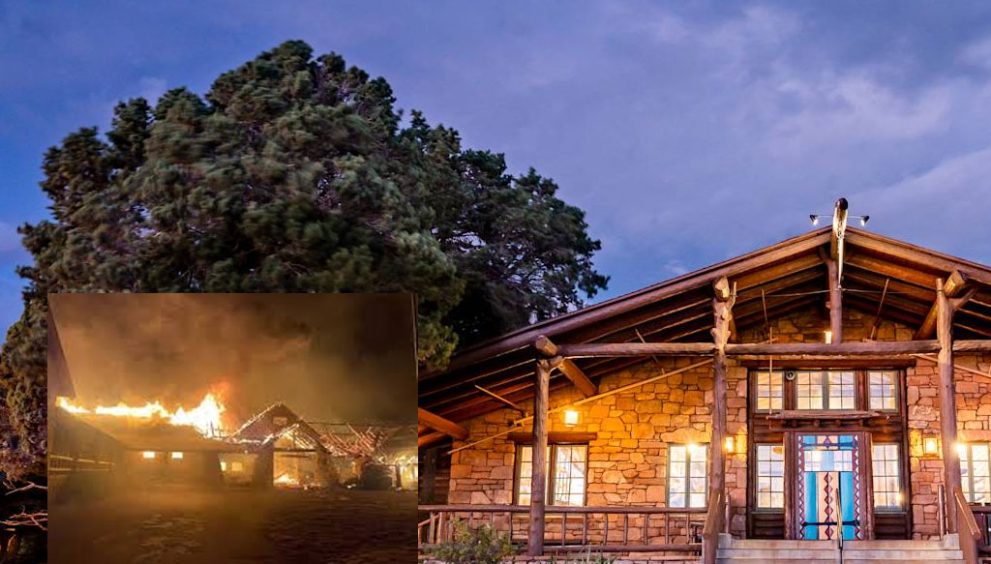Grand Canyon Lodge Destroyed by Dragon Bravo Wildfire: A Historic Tragedy Unfolds

On July 12, 2025, a catastrophic wildfire known as the Dragon Bravo Fire razed the iconic Grand Canyon Lodge, a century-old gem perched on Arizona’s North Rim. This devastating event, fueled by relentless winds and unforgiving conditions, not only obliterated a historic landmark but also left an indelible mark on the Grand Canyon National Park’s legacy. For www.clickusanews.com, we dive into the gripping tale of this tragedy, exploring its origins, impact, and the resilient spirit of a community determined to rebuild.
The Spark That Ignited a Catastrophe
The story began on July 4, 2025, when a lightning strike ignited the tinder-dry landscape of the Kaibab National Forest within Grand Canyon National Park. Named the Dragon Bravo Fire, the blaze was initially managed as a controlled burn, a common strategy to clear dead vegetation and promote ecological health. The North Rim, a serene escape attracting only 10% of the park’s nearly five million annual visitors, seemed untouched, with the Grand Canyon Lodge standing as a stoic sentinel amidst the distant smoke.
But nature had other plans. On July 11, a sudden shift in weather brought fierce northwest winds, gusting up to 40 mph, transforming the controlled burn into a raging inferno. By the night of July 12, the Dragon Bravo Fire had surged, consuming 5,000 acres and exhibiting what park officials described as “extreme fire behavior.” The flames tore through Roaring Springs and Transept Canyons, engulfing the lodge and surrounding structures in a matter of hours.
The Grand Canyon Lodge: A Timeless Treasure
To grasp the magnitude of this loss, one must understand the lodge’s significance. Constructed in 1927–1928 by the Utah Parks Company, a Union Pacific Railroad subsidiary, the Grand Canyon Lodge was a masterpiece by architect Gilbert Stanley Underwood. Its Kaibab limestone walls and massive ponderosa pine beams blended seamlessly with the rugged North Rim, embodying rustic elegance. A kitchen fire in 1932 destroyed the original structure, but it was meticulously rebuilt in 1937, cementing its status as a National Historic Landmark.
The lodge was more than a place to stay; it was a time capsule. Its grand lobby, adorned with a 600-pound bronze statue of “Brighty the Burro,” a beloved Grand Canyon icon, housed irreplaceable archives—documents, photographs, and artifacts chronicling the park’s history. “Walking into the lodge felt like stepping back a hundred years,” said Flagstaff resident and avid hiker Tim Allen, who visited the North Rim annually. “The smell of pine, the creak of the floors—it was like the canyon itself was telling you its story.”
For visitors like the Carney family—evacuated on July 10 with their 12-year-old son—the lodge was a haven for creating memories. “We’d sit in the dining hall, watching the sunset over the canyon,” Caren Carney recalled. “It was magical. Now, it’s just… gone.”
The Night the North Rim Burned
As the Dragon Bravo Fire intensified, the North Rim became a scene of chaos and urgency. On July 10, park rangers went door-to-door, ordering the evacuation of guests and staff. Caren Carney described the moment: “The ranger was calm but firm. We grabbed our bags and left, not knowing we’d never see the lodge again.” By Saturday, July 12, the fire’s ferocity overwhelmed firefighting efforts. Fueled by 100-degree temperatures, 10% humidity, and relentless winds, it consumed 50 to 80 structures, including the lodge, the visitor center, a gas station, administrative buildings, and employee housing.
A particularly devastating blow came with the destruction of a wastewater treatment plant, which triggered a chlorine gas leak. This forced the closure of inner canyon trails like North Kaibab and South Kaibab, stranding hikers and disrupting rafting operations along the Colorado River. The nearby White Sage Fire, burning 40,000 acres near Jacob Lake, further strained resources, leaving firefighters battling two uncontained blazes under “dangerous and fast-changing conditions.” Aerial bucket drops were attempted, but the chlorine gas hazard halted retardant efforts, allowing the flames to spread unchecked.
A Nation Mourns, a Community Responds
The destruction of the Grand Canyon Lodge sent shockwaves across the United States. Social media platforms like X captured the collective grief, with users sharing memories and mourning the loss. “The Grand Canyon Lodge is gone. A piece of history reduced to ashes,” posted @CanyonDreamer, alongside a photo of the lodge’s iconic facade. Another user, @WildWestSoul, wrote, “Heartbroken for the North Rim. That lodge was a sanctuary.”
Aramark, the lodge’s operator, released a statement: “We are devastated by the loss of the Grand Canyon Lodge and other historic structures. Our priority was ensuring the safety of our employees and guests, all of whom were evacuated without injury.” Arizona Governor Katie Hobbs, addressing the crisis on July 13, called for a federal investigation into the initial decision to manage the fire as a controlled burn. “With wildfires growing more severe due to climate change, we need proactive strategies, not reactive regrets,” she said. Congressman Greg Stanton added, “This tragedy underscores the urgent need for investment in wildfire prevention and forest management.”
The Grand Canyon Historical Society, led by president Thomas Sulpizio, expressed concern over the loss of irreplaceable artifacts. “The lodge held records and relics that told the North Rim’s story,” he said. “We’re still assessing what, if anything, can be salvaged.”
The Road Ahead: Rebuilding a Legacy
As of July 14, 2025, the Dragon Bravo Fire remains at 0% containment, with 5,000 acres burned, while the White Sage Fire has scorched 40,000 acres. The North Rim is closed for the season, leaving its trails, viewpoints, and remaining facilities inaccessible. Fire management teams, bolstered by national resources, are making progress on the White Sage Fire, but the Dragon Bravo’s volatile behavior continues to challenge responders. Phantom Ranch, deep in the canyon, recorded a scorching 115 degrees on July 13, complicating ground efforts.
Yet, amidst the devastation, there is hope. The Grand Canyon’s spirit, like its vast chasms, endures. Local communities, park officials, and visitors are already discussing plans to rebuild, drawing inspiration from the lodge’s 1937 resurrection. “The canyon has seen fire before,” said Tim Allen. “It’s a place of renewal. We’ll rebuild, and it’ll be beautiful again.”
For now, the North Rim stands as a testament to nature’s power and humanity’s resilience. The Grand Canyon Lodge may be gone, but its legacy lives in the memories of those who stood on its verandas, gazed into the abyss, and felt the weight of time. As the park looks to the future, one thing is certain: the story of the Grand Canyon is far from over.













